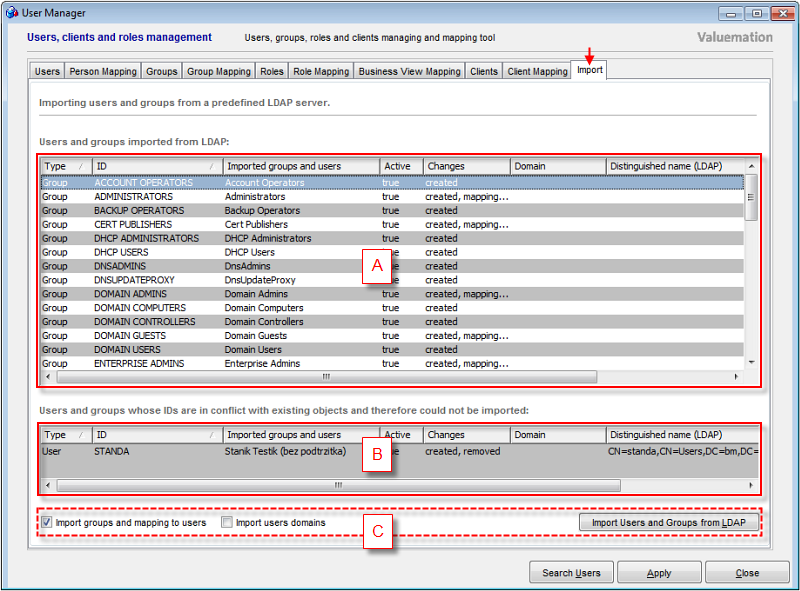Import
On the Import tab, you can import external users and groups from the LDAP server. As LDAP is the leading system, incoming information from LDAP is regarded as correct and up-to-date, even if it differs from the information in Valuemation. The information in Valuemation is altered so that it once again matches the information in LDAP.
If the LDAP database has been modified (e.g. there is a new employee in the company), the import function should be run again. Normally the import function should be run at regular intervals. The import function compares the current information in Valuemation with the incoming information from LDAP and updates Valuemation to the current state.
New users or groups from LDAP which did not previously exist are created in Valuemation. If existing users or groups are no longer contained in the LDAP listing, they are deleted from Valuemation. Any mapping is also deleted. Any other change like a change of a surname or the mapping to groups is reflected in Valuemation automatically.

The Import window after the import.
The Import window contains the two lists:
- Imported Users and Groups
Contains users and groups that are new or have been changed since the last import, provided that there is no conflict with the existing internal users or groups.
- Conflicting Users and Groups
Displays users and groups with a conflict that were not imported. A conflict would arise e.g. if there is an existing user in the same domain (created manually as an internal user). The conflicting users and groups are displayed in the list and are not imported.
Both tables contain the following columns:
- Type
Displays the type of the item. Possible values: User or Group.
- ID
Displays the ID of the user.
- Imported groups and users
Name of the user/group.
- Active
Shows the status of the user or group – whether it is active or not. Possible values are True / False.
- Changes
Shows status of changes since last import. Possible values are: created, removed, edited, activated, deactivated, mappings added, mappings removed.
- Domain
Shows the corresponding domain.
- Distinguished Name (LDAP)
The LDAP API references an LDAP object by its distinguished name (DN). A DN is a sequence of relative distinguished names (RDN) connected by commas. An RDN is an attribute with an associated value in the form attribute=value.
The Import window contains one control button:
- Import Users and Groups from LDAP
Starts the import.
NOTE: The Import table displays only new items or those that have been changed since the last update. It is empty if no difference between the user/group information hold by Valuemation and that on the LDAP was detected.
NOTE: External (imported) users and groups cannot be edited in Valuemation. Any changes to the external users and groups should be made directly on LDAP server.